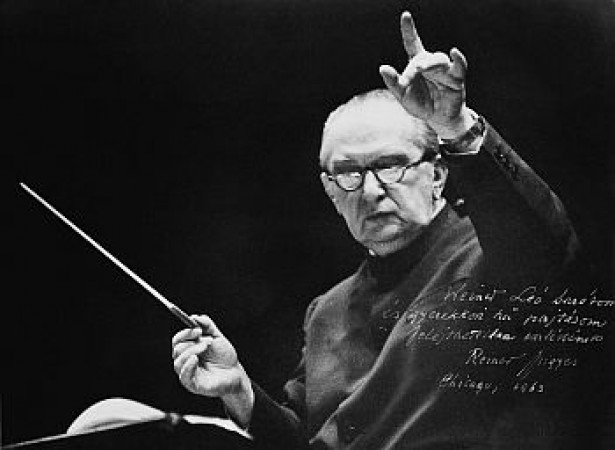
19 December 1888, Budapest – 15 November 1963, New York
Fritz Reiner was one of the greatest conductors of the 20th century. Like so many other musicians of Hungarian origin, for much of his career it was abroad that he earned recognition and fame for Hungarian music.
Though he organised and conducted the school orchestra while still a secondary school pupil, he never had any formal training in conducting. He entered the piano and composition classes at the Music Academy, studying piano at first with István Thomán, and then, following Thomán's retirement, with Béla Bartók. His composition teacher was János Koessler.
Reiner began his career as a coach – together with his one-time schoolmates and friends, Leo Weiner and Albert Szirmai - at the Budapest Népszinház and Vígopera (Volk Theatre and Comic Opera). One evening he replaced the conductor, who had fallen ill, and won tremendous acclaim. In 1910 he joined the Laibach (Ljubljana) theatre, conducting Smetana's Dalibor for his first performance there. A year later he was back in Budapest, as conductor at the Népopera (Volks Opera). It was here that he taught and conducted Wagner's Parsifal on 1 January 1914, the first performance of the opera outside Bayreuth, immediately after the author's rights had lapsed. According to the report in Magyar Estilap, "Frigyes Reiner, this young musician of genius, did a first class job in coaching the opera's ensemble in this extraordinarily difficult work".
In May 1914, Reiner joined the Dresden Staatsoper, as a late inheritor of Wagner's one-time post. He came into contact with Artur Nikisch, who had a strong influence on his conducting style, as well as such great composer-conductors as Gustav Mahler and Richard Strauss, whose works accompanied the Hungarian conductor throughout his career. Reiner conducted Richard Strauss's The Woman without a Shadow in Dresden in 1919, the first performance of the opera in Germany, immediately following its Vienna premier.
At the beginning of the1920's he performed in Rome, Barcelona and Buenos Aires. In 1922, he was invited to become the leading conductor of the Cincinatti Symphony Orchestra. From that time onwards right to his death he lived in the United States. In 1929 he became the conductor of the New York Philharmonic Orchestra. From 1931 he taught conducting as professor of the orchestra and opera department of the Philadelphia Curtis Institute. His pupils included Leonard Bernstein. "Any student who has completed my course" – Reiner said – "can stand up in front of an orchestra completely unknown to him and can sight-read a new work, without any verbal explanation".
The next stages in his increasingly brilliant career were the Pittsburgh Symphony Orchestra, and then the New York Metropolitan Opera House. His introductory performance at the Met was with Richard Strauss's Salome; he also conducted the American premier of Stravinsky's The Rake's Progress in 1953. During the same year he joined the Chicago Symphony Orchestra, which, though one of America's oldest orchestras, was considered at the time to be of only average standard. Under Reiner it became "the most accurate and flexible ensemble in the world" (Stravinsky). After ten years with the Chicago Symphony Orchestra, Reiner returned to the Metropolitan, where he died during the rehearsals of Götterdammerung, on 15 November 1963, at the age of 75.
He returned on several occasions in the course of his career, by then as an American citizen, to Europe, and to the country of his birth. He visited Budapest in 1926, 1933 and 1937. On the last occasion he conducted the Orchestra of the Philharmonic Society in Brahms's Fourth Symphony and Richard Strauss's Till Eulenspiegel in the Erkel Theatre. In the same year he appeared at the London Covent Garden at the invitation of Thomas Beecham; the performance of Tristan and Isolde conducted by him was also the first appearance of Kirsten Flagstad in London. In 1955 the rebuilt Vienna Staatsoper opened with Der Rosenkavalier, conducted by Reiner.
Reiner did a great deal to get the conservative American audience to know and love the new Hungarian music of Kodaly, Weiner, and, first and foremost, Bartók. Having performed several Bartók works (First and Second Suite, Dance Suite, The Miraculous Mandarin Suite), he conducted the performance of the First Piano Concerto in New York in 1928 with the participation of the composer himself, and the Second Piano Concerto in Pittsburgh in January 1941. Bartók in his emigration considered Weiner as a friend and as one of the best interpreters of his music. The original premier of the orchestral version of his Sonata for Two Pianos and Percussion in New York on 21 January 1943, conducted by Reiner, with the participation of Bartók and Ditta Pásztory, was a music historical event: this was the last time that the composer appeared as a pianist in front of an audience.
Fritz Reiner's art is preserved on many excellent recordings; besides the Hungarian and German repertoire, a number of memorable Mozart performances, as well as outstanding recordings of Carmen and Falstaff, are connected with his name. Reiner the man had a puritanical character, as a trainer of orchestras he was strict and exacting. This severity aimed always and exclusively at quality, at the most precise working out of the rhythms and proportions of sound. He conducted with sparing movements, avoided both romantic sentimentality and excessive objectivity; his interpretations were characterised by a fire within classically formed proportions.
M.P.


